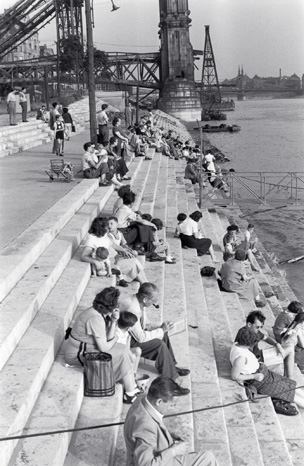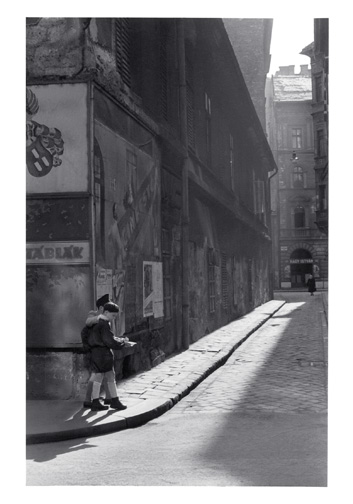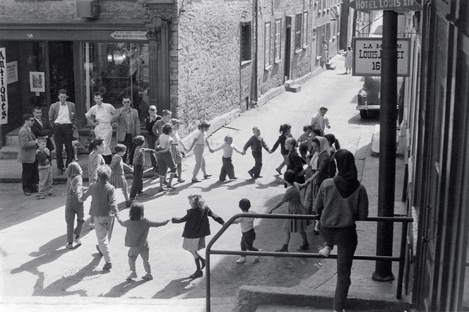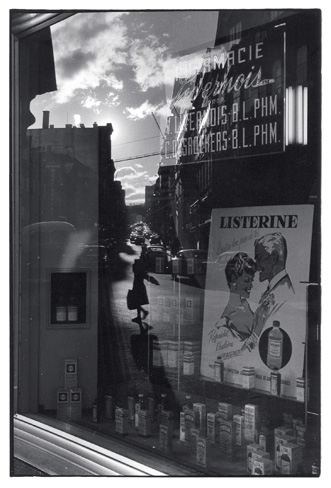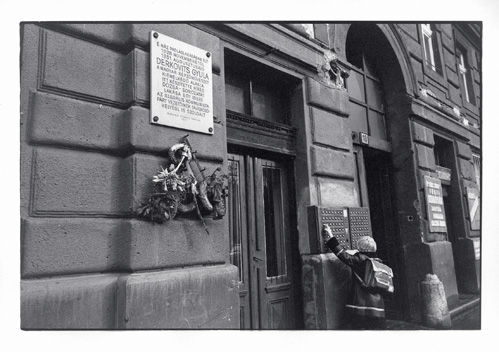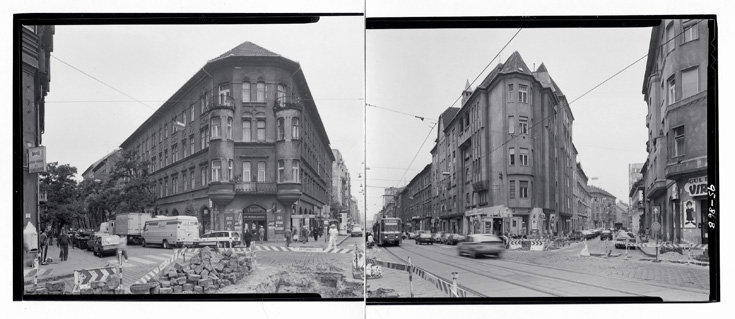[Fall 2006]
What is less well known is that he photographed in Hungary around the time of his flight to Canada in 1957 and again during his return to Budapest more than twenty years later. Photography was fundamental to Szilasi’s experience: it acted as a means for him to both articulate and negotiate the disjunction between his memory and the present-day reality of home. These images taken during his exile1 and return, few of which have been shown or published, represent keystones in his life and predict the attention to time and change apparent in his oeuvre.
Prior to his coming to Canada, Szilasi regarded photography as just a serious hobby. He bought his first camera in 1952, when he was twenty-four. When he looked through books and magazines at the Alliance Française, he was influenced by European street photographers such as Cartier-Bresson and Kertesz. Szilasi went out into the streets of Budapest and looked, capturing the city as he saw it (figures 1 and 2). These early photographs describe his relationship with photography as new, fresh, and open. They picture not only his joy in translating what he saw around him to film and paper, but also a romantic vision of his home despite the increasing political tension.
The Hungarian Uprising began on October 23, 1956, when an anti-Soviet demonstration led by students and working-class citizens of Budapest turned violent.2 Szilasi documented the uprising from November 15 to 25 (figure 3). This image and others like it were the last he took of his home before he fled. In late November, Szilasi and his father escaped to Austria. In January of 1957, they boarded a ship for Canada. Upon arrival, Szilasi was diagnosed with tuberculosis, and he was quarantined for the better part of that year. Once released, he began to photograph his new home, Quebec City.
Szilasi was accustomed to seeing the world through the lens of a camera and in the frame of a photograph – he delighted in it. Much as he had in Budapest, Szilasi went out into the streets of Quebec City and looked, capturing this place that was new to him (plates 3, 4, and 5). He learned his surroundings while photographing. Looking at Quebec City through the lens made it appear familiar; he was using a language he knew to describe something foreign. Salman Akhtar, in his article, “The Immigrant, the Exile, and the Experience of Nostalgia,” describes the process by which objects and possessions from the exile’s former life can act as “linking objects” between the homeland and the present.3 Although Szilasi approached his immigration in a highly rational manner, claiming that he “accepted the fact that [he] was in a new country and wanted to integrate as much as [he] could,”4 photography was a “linking object” between his memory of his former home in Budapest and the reality of his new home in Quebec. It helped him to negotiate the transition. Compare, for instance, Szilasi’s 1955 photograph of two boys in the streets of Budapest (figure 2) to the 1957 image of children in Quebec City (figure 3). With their child subjects and the long stroke of sunlight painting the street, these images have an uncanny resemblance. Both photographs are romantic, if not idyllic – a sign of Szilasi’s search for his former idea of home. His memory of Budapest was a lens through which he viewed Quebec City; photography allowed him to claim Quebec and Canada as home.
In January of 1959, Szilasi moved to Montreal, where he took up permanent residence. While working for the Office du Film du Québec, he moved into large-format photography, which quickly became crucial to his method and style. In 1970, he photographed the Charlevoix region – a body of work that brought him much attention from the photographic community. When I spoke to him about this series, he said, “[I wanted to] preserve something as a souvenir. Even at that time, I thought it was [important] to record things as they are because of constant change. Maybe it was subconscious but I felt that need for that.”5 This comment speaks to a desire for stability in the face of much change both within himself and in the communities around him. That being the case, photography was the perfect medium for Szilasi to express his awareness of instability: it can make permanent even a fleeting moment.6
In 1980, Szilasi returned to Budapest for the first time since his exile, bringing with him only his 35 mm camera. “I was looking for something that used to be very familiar,” he said, “wondering if it was still there or how it had changed.”7 Over the next fifteen years, he returned four more times with his viewfinder camera in tow. His photographs – whether from his first or his fifth trip – illustrate this relationship of relearning how to describe his homeland. These images do not connote mourning or loss; rather, they are introspective, attentive to the ambiguity he felt toward past and present-day Budapest. The city was simultaneously strange and familiar. In photographing his homeland in the 1980s and 1990s, Szilasi was searching for the Budapest of his memory.
Consider this montage of a busy intersection from the 1990s (figure 7): despite the modern cars, vans, signage, and clothing of the passers-by in this image, the old structures are the true subjects – the same architecture and cobblestone streets are seen in his 1955 photograph of the boys in the street (figure 1). In her essay “A Journey Through Memory,” Annette Kuhn writes that “memory never provides access to or represents the past ’as it was’; that the past is always mediated – rewritten, revised – through memory.”8 By choosing to document the aspects of the city that appeared similar to his memory of Budapest, Szilasi used photography to mediate between the past and the present. In fact, his romantic photographs of his homeland in the 1950s can be likened to what Kuhn calls “memory texts,” which are “characteristically collagist, fragmentary, [and] timeless.”9 “Memory texts are metaphorical,” writes Kuhn, which is indicative of this montage of a Budapest street corner. Both the old architecture juxtaposed against a contemporary society and the construction/destruction of the cobblestone streets pictured in the foreground can be interpreted as symbols of change, of the shift from the old to the new Budapest. Within the space of a photograph, Szilasi brought together his memory of Budapest and the present-day reality of a much-changed city.
Comparing this montage of old Budapest architecture to one of structures alien to Szilasi’s memory reveals another level of his desire to bridge the gap between past and present. These box-like apartment buildings are stark, cold, and lack the visual flare of the older architecture (figure 8). Furthermore, this image is in direct contrast to the montage of old Budapest architecture in that the negative spaces of one image are almost identical in size and shape to the positive spaces of the other. “Ugly,” he called these newer buildings10 – as if by photographing them he was attempting to draw attention to the fact that they do not belong to his idea of his former home. Moreover, in choosing to describe these buildings with the same formal tools that he used to document the old Budapest architecture, Szilasi used photography to translate between old and new, between his simultaneous feelings of dislocation and belonging. Much like during his integration into life in Quebec, he used photography to seek out the familiar in this now-strange land. Photography enabled him to come to terms with change and transition—to renegotiate home.
2 “Hungarian Uprising (1956),” Encyclopaedia of Marxism, 1999–2004, .
3 V.D. Volkan quoted in Salman Akhtar, “The Immigrant,” p. 125.
4 Gabor Szilasi, personal interview, November 14, 2005.
5 Ibid.
6 Roland Barthes, Camera Lucida: Reflections on Photography, trans. Richard Howard (New York: Hill and Wang, 1981), p. 4.
7 Gabor Szilasi, personal interview, October 31, 2005.
8 Annette Kuhn, “A Journey Through Memory,” in Susannah Radstone (ed.), Memory and Methodology (Oxford and New York: Berg, 2000), p. 186.
9 Ibid., p. 190.10 Gabor Szilasi, personal interview, November 14, 2005.
Sharon Murray is a master’s student in art history at Concordia funded by a SSHRC Graduate Scholarship. She holds a BFA in photography from NSCAD.

